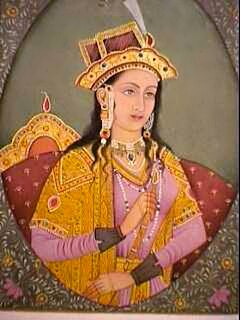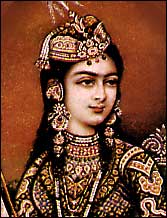
Nur-ud-din Muhammad Salim, known by his imperial name Jahangir, was the fourth Mughal Emperor, who ruled from 1605 until his death in 1627. His imperial name, means 'conqueror of the world', 'world-conqueror' or 'world-seizer'.

Shahab-ud-din Muhammad Khurram, better known by his regnal name Shah Jahan, was the fifth Mughal emperor, who reigned from 1628 to 1658. He is widely considered one of the greatest Mughal emperors; under his reign the Mughal Empire reached the peak of its glory. Although an able military commander, Shah Jahan is perhaps best remembered for his architectural achievements. His reign ushered in the golden age of Mughal architecture. Shah Jahan commissioned many monuments, the best known of which is the Taj Mahal in Agra, which entombs his favourite wife, Mumtaz Mahal. His relationship with Mumtaz Mahal has been heavily adapted into Indian art, literature, and cinema.

Fatehpur Sikri is a town in the Agra District of Uttar Pradesh, India. The city itself was founded as the capital of Mughal Empire in 1571 by Emperor Akbar, serving this role from 1571 to 1585, when Akbar abandoned it due to a campaign in Punjab and was later completely abandoned in 1610.

Agra is a city on the banks of the Yamuna river in the Indian state of Uttar Pradesh. It is 206 kilometres (128 mi) south of the national capital New Delhi. Agra is the fourth-most populous city in Uttar Pradesh and 24th in India.

Akbar II, also known as Akbar Shah II, was the penultimate Mughal emperor of India. He reigned from 1806 to 1837. He was the second son of Shah Alam II and the father of Bahadur Shah II.

The Walled City of Lahore, also known as Old City, forms the historic core of Lahore, Pakistan. The city was established around 1000 CE in the western half of the Walled City, which was fortified by a mud wall during the medieval era.

Agra Fort is a historical fort in the city of Agra in India. It was the main residence of the emperors of the Mughal Dynasty until 1638, when the capital was shifted from Agra to Delhi. Before capture by the British, the last Indian rulers to have occupied it were the Marathas. In 1983, the Agra fort was inscribed as a UNESCO World Heritage site. It is about 2.5 km northwest of its more famous sister monument, the Taj Mahal. The fort can be more accurately described as a walled city.

Hemu was a Hindu king who previously served as a general and Chief Minister of Adil Shah Suri of the Suri dynasty during a period in Indian history when the Mughals and Afghans were vying for power across North India. He fought Afghan rebels across North India from the Punjab to Bengal and the Mughal forces of Humayun and Akbar in Agra and Delhi, winning 22 battles for Adil Shah.

Mughal architecture is the type of Indo-Islamic architecture developed by the Mughals in the 16th, 17th and 18th centuries throughout the ever-changing extent of their empire in the Indian subcontinent. It developed the styles of earlier Muslim dynasties in India as an amalgam of Islamic, Persian, Turkic and Indian architecture. Mughal buildings have a uniform pattern of structure and character, including large bulbous domes, slender minarets at the corners, massive halls, large vaulted gateways, and delicate ornamentation; "grandiose architecture was the most visible of the ways that the Mughals used to assert their sense of superiority and their supremacy over what in many ways remained to them an alien land". Examples of the style can be found in modern-day India, Afghanistan, Bangladesh, and Pakistan.

Raja Man Singh was the Kachwaha Rajput Raja of Amer, a state later known as Jaipur in Rajputana. He was a trusted general of the Mughal emperor Akbar, who included him among the Navaratnas, or the nine (nava) gems (ratna) of the royal court of Akbar.

Mariam-uz-Zamani, was a wife of the Mughal emperor Akbar. She has also been referred to by several other names, including Hira Kunwari, Harkha Bai and Jodha Bai.

Allahabad is one of the largest cities of the North Indian state of Uttar Pradesh in India. Although initially named Ilahabas the name later became Allahabad in an anglicized version in Roman script. In 2018 the name of the city was changed to Prayagraj by the State government ruled by Yogi Adhityanath . The city is situated on an inland peninsula, surrounded by the rivers Ganges and Yamuna on three sides, with only one side connected to the mainland Doab region, of which it is a part. This position is of importance in Hindu scriptures for it is situated at the confluence, known as Triveni Sangam, of the holy rivers. As per Rigveda the Sarasvati River was part of the three river confluence in ancient times. It is one of four sites of the Kumbh Mela, an important mass Hindu pilgrimage.

Abu'l-Fath Jalal-ud-din Muhammad Akbar, popularly known as Akbar the Great,, and also as Akbar I, was the third Mughal emperor, who reigned from 1556 to 1605. Akbar succeeded his father, Humayun, under a regent, Bairam Khan, who helped the young emperor expand and consolidate Mughal domains in India.

Hamida Banu Begum was a wife of the second Mughal emperor Humayun and the mother of his successor, the third Mughal emperor Akbar. She is also known by the title Maryam Makani, which was given to her by her son, Akbar.

Jagat Gosain was Empress consort of the Mughal Empire as the wife of Mughal emperor Jahangir and the mother of his successor, the fifth Mughal emperor Shah Jahan. She is also known as Jodh Bai and was given the posthumous title of Bilqis Makani. She should not be confused with Mariam-uz-Zamani, who was also wrongly named "Jodha Bai" by European historians.

The Chunar Fort is located in Mirzapur district of Uttar Pradesh, in India. Along with Chunar town, situated below the fort, the two are historic places with common history and legends. It is located 23 kilometres (14 mi) south west of Varanasi. The southeastern part of the fort is on the rocky bank of the Ganges River. The fort's history spans from 56 BC and then between Afghan decedent Sher Shah Suri's (1532) rule, the Mughal Empire rule up to 1772, and finally the British Raj up to 1947 till India gained independence. Chunar railway station is on the Mughalsarai-Kanpur section of Howrah-Delhi main line.
Ruqaiya Sultan Begum was empress consort of the Mughal Empire from 1557 to 1605 as the first wife and chief consort of the third Mughal emperor Akbar. She was also the longest serving Mughal empress, having a tenure of almost fifty years.

Salima Sultan Begum was the fourth wife of the Mughal Emperor Akbar, and the granddaughter of Babur.

Hemu's Smadhi Sthal, is a memorial to the Hindu king Hemu Bhargav at Shodapur village on Jind road near Panipat city in Panipat district of Haryana state in India. It stands at the location where he was executed.

Karam Chand Bachhawat (1542-1607) (विभूति) was the dewan of Bikaner State in the former Rajputana from 1571 to 1591. Chand, a descendant of Bachhraj, was a strategist in Bikaner and had a good relationship with Akbar. In 1591, fearing for his life, he resigned. At Akbar's invitation, Chand later joined the emperor as an adviser to the Lahore court.


















